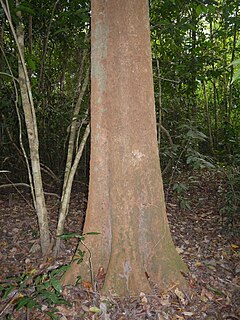
Castanopsis, commonly called chinquapin or chinkapin, is a genus of evergreen trees belonging to the beech family, Fagaceae. The genus contains about 120 species, which are today restricted to tropical and subtropical eastern Asia. A total of 58 species are native to China, with 30 endemic; the other species occur further south, through Indochina to Indonesia, mountainous areas of Taiwan, and also in Japan. The English name chinkapin is shared with other related plants, including the golden chinkapins of the Pacific United States, which are sometimes included within Castanopsis but are more often considered a separate but very closely related genus, Chrysolepis.

Scaphium affine is a tree species in the family Malvaceae, subfamily Sterculioideae. It is native to mainland Southeast Asia and no subspecies are listed in the Catalogue of Life.

Zakerana pierrei is a species of frog in the family Dicroglossidae. It is found in Nepal, adjacent India, and eastern Bangladesh. It has recently been reported also from Bhutan. It is a common species associated with paddy fields.
Swintonia is a genus of plants in the family Anacardiaceae.
Swintonia spicifera is a species of plant in the family Anacardiaceae. It is found in Indonesia, Malaysia, and the Philippines. Swintonia spicifera grows as a tree on hill and mountain ridges.

Xylopia is a genus of flowering plants in the family Annonaceae. They are mostly trees and some shrubs. There are about 160 species distributed in Asia, Africa, and the Americas.
Xylopia pierrei is a tree species in the family Annonaceae and its native range is Thailand to southern Vietnam.

Uraria is a genus of plants in the family, Fabaceae. It belongs to the subfamily Faboideae and the tribe Desmodieae.
Labeo pierrei is a species of freshwater ray-finned fish in the genus Labeo native to the Mekong, Đồng Nai, and Chao Phraya basins in Cambodia, Thailand, and Vietnam.

Helixanthera is moderately sized genus of showy mistletoe with over 40 species from tropical Africa, southern Asia and Malesia. The genus was described already 1790 by the Portuguese botanist João de Loureiro in his Flora Cochinchinensis. A new species, Helixanthera schizocalyx, was described in 2010.

Taxillus is a plant genus in the mistletoe family: Loranthaceae.

Parinari anamensis is a dicotyledonous plant species that was described by Henry Fletcher Hance from southern Vietnam. It has been called Annamese burada and is now placed in the family Chrysobalanaceae,. No subspecies are listed in the Catalogue of Life.

Illigera is a genus of flowering plants in the family Hernandiaceae, found tropical regions of Africa and Asia.
Illigera rhodantha is a species of liana in the family Hernandiaceae. It is found in subtropical and tropical forests of China and Indo-China; its Vietnamese name is dây ba chẽ. The Catalogue of Life lists the subspecies I. rhodantha dunniana.

Swintonia floribunda is a tree species in the family Anacardiaceae. It can be found in the Andaman Islands, Indo-China and Malesia through to Sumatra.
Parishia maingayi is an Asian tree species in the family Anacardiaceae. Records of occurrence include: peninsular Malaysia, Sumatra, Borneo and the Philippines; the Catalogue of Life lists one subspecies: P. maingayi minor.
Garuga pierrei is a tropical forest tree species in the family Burseraceae. It occurs in China and Indo-China; in Vietnam it may be called cốc đá or chua luy; no subspecies are listed in the Catalogue of Life.
The tree Castanopsis pierrei is in the family Fagaceae. It is found in Thailand and Cambodia. It provides fuel, food and crop-shading.
Occurring as a shrub or as a tree, Daphniphyllum majus is a species in the family Daphniphyllaceae. It is found in Mainland Southeast Asia and Yunnan in Zhōngguó/China. Uses of the plant include fuel and smoking-material.









